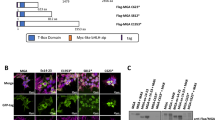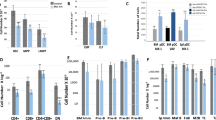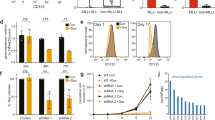Abstract
Deleted in Liver Cancer 1 (DLC1) is a tumor suppressor whose allele is lost in 50% of liver, breast, lung and 70% of colon cancers. Here, we show that the transcriptional coactivators Megakaryoblastic Leukemia 1 and 2 (MKL1/2) are constitutively localized to the nucleus in hepatocellular and mammary carcinoma cells that lack DLC1. Moreover, DLC1 loss and MKL1 nuclear localization correlate in primary human hepatocellular carcinoma. Nuclear accumulation of MKL1 in DLC1-deficient cancer cells is accomplished by activation of the RhoA/actin signaling pathway and concomitant impairment of MKL1 phosphorylation, which results in constitutive activation of MKL1/2 target genes. We provide evidence that MKL1/2 mediates cancerous transformation in DLC1-deficient hepatocellular and mammary carcinoma cells. Depletion of MKL1/2 suppresses cell migration, cell proliferation and anchorage-independent cell growth induced by DLC1 loss.
This is a preview of subscription content, access via your institution
Access options
Subscribe to this journal
Receive 50 print issues and online access
$259.00 per year
only $5.18 per issue
Buy this article
- Purchase on Springer Link
- Instant access to full article PDF
Prices may be subject to local taxes which are calculated during checkout







Similar content being viewed by others
References
Cen B, Selvaraj A, Burgess RC, Hitzler JK, Ma Z, Morris SW et al. (2003). Megakaryoblastic leukemia 1, a potent transcriptional coactivator for serum response factor (SRF), is required for serum induction of SRF target genes. Mol Cell Biol 23: 6597–6608.
Clark EA, Golub TR, Lander ES, Hynes RO . (2000). Genomic analysis of metastasis reveals an essential role for RhoC. Nature 406: 532–535.
Farazi PA, DePinho RA . (2006). Hepatocellular carcinoma pathogenesis: from genes to environment. Nat Rev Cancer 6: 674–687.
Friedl P, Wolf K . (2003). Tumour-cell invasion and migration: diversity and escape mechanisms. Nat Rev Cancer 3: 362–374.
Giehl K . (2005). Oncogenic Ras in tumour progression and metastasis. Biol Chem 386: 193–205.
Gollob JA, Wilhelm S, Carter C, Kelley SL . (2006). Role of Raf kinase in cancer: therapeutic potential of targeting the Raf/MEK/ERK signal transduction pathway. Semin Oncol 33: 392–406.
Gomez del Pulgar T, Benitah SA, Valeron PF, Espina C, Lacal JC . (2005). Rho GTPase expression in tumourigenesis: evidence for a significant link. Bioessays 27: 602–613.
Goodison S, Yuan J, Sloan D, Kim R, Li C, Popescu NC et al. (2005). The RhoGAP protein DLC-1 functions as a metastasis suppressor in breast cancer cells. Cancer Res 65: 6042–6053.
Hakem A, Sanchez-Sweatman O, You-Ten A, Duncan G, Wakeham A, Khokha R et al. (2005). RhoC is dispensable for embryogenesis and tumor initiation but essential for metastasis. Genes Dev 19: 1974–1979.
Hanna M, Liu H, Amir J, Sun Y, Morris SW, Siddiqui MA et al. (2009). Mechanical regulation of the proangiogenic factor CCN1/CYR61 gene requires the combined activities of MRTF-A and CREB-binding protein histone acetyltransferase. J Biol Chem 284: 23125–23136.
Heering J, Erlmann P, Olayioye MA . (2009). Simultaneous loss of the DLC1 and PTEN tumor suppressors enhances breast cancer cell migration. Exp Cell Res 315: 2505–2514.
Jaffe AB, Hall A . (2005). Rho GTPases: biochemistry and biology. Annu Rev Cell Dev Biol 21: 247–269.
Knoll B . (2010). Actin-mediated gene expression in neurons: the MRTF-SRF connection. Biol Chem 391: 591–597.
Knoll B, Kretz O, Fiedler C, Alberti S, Schutz G, Frotscher M et al. (2006). Serum response factor controls neuronal circuit assembly in the hippocampus. Nat Neurosci 9: 195–204.
Lahoz A, Hall A . (2008). DLC1: a significant GAP in the cancer genome. Genes Dev 22: 1724–1730.
Lee SM, Vasishtha M, Prywes R . (2010). Activation and repression of cellular immediate early genes by serum response factor cofactors. J Biol Chem 285: 22036–22049.
Maekawa M, Ishizaki T, Boku S, Watanabe N, Fujita A, Iwamatsu A et al. (1999). Signaling from Rho to the actin cytoskeleton through protein kinases ROCK and LIM-kinase. Science 285: 895–898.
Mattila PK, Lappalainen P . (2008). Filopodia: molecular architecture and cellular functions. Nat Rev Mol Cell Biol 9: 446–454.
Mazzocca A, Fransvea E, Dituri F, Lupo L, Antonaci S, Giannelli G . (2010). Down-regulation of connective tissue growth factor by inhibition of transforming growth factor beta blocks the tumor-stroma cross-talk and tumor progression in hepatocellular carcinoma. Hepatology 51: 523–534.
Medjkane S, Perez-Sanchez C, Gaggioli C, Sahai E, Treisman R . (2009). Myocardin-related transcription factors and SRF are required for cytoskeletal dynamics and experimental metastasis. Nat Cell Biol 11: 257–268.
Miano JM, Long X, Fujiwara K . (2007). Serum response factor: master regulator of the actin cytoskeleton and contractile apparatus. Am J Physiol Cell Physiol 292: C70–C81.
Miralles F, Posern G, Zaromytidou AI, Treisman R . (2003). Actin dynamics control SRF activity by regulation of its coactivator MAL. Cell 113: 329–342.
Morin P, Flors C, Olson MF . (2009). Constitutively active RhoA inhibits proliferation by retarding G(1) to S phase cell cycle progression and impairing cytokinesis. Eur J Cell Biol 88: 495–507.
Muehlich S, Cicha I, Garlichs CD, Krueger B, Posern G, Goppelt-Struebe M . (2007). Actin-dependent regulation of connective tissue growth factor. Am J Physiol Cell Physiol 292: C1732–C1738.
Muehlich S, Wang R, Lee SM, Lewis TC, Dai C, Prywes R . (2008). Serum-induced phosphorylation of the serum response factor coactivator MKL1 by the extracellular signal-regulated kinase 1/2 pathway inhibits its nuclear localization. Mol Cell Biol 28: 6302–6313.
Pipes GC, Creemers EE, Olson EN . (2006). The myocardin family of transcriptional coactivators: versatile regulators of cell growth, migration, and myogenesis. Genes Dev 20: 1545–1556.
Porter KE, Turner NA, O'Regan DJ, Balmforth AJ, Ball SG . (2004). Simvastatin reduces human atrial myofibroblast proliferation independently of cholesterol lowering via inhibition of RhoA. Cardiovasc Res 61: 745–755.
Prange W, Breuhahn K, Fischer F, Zilkens C, Pietsch T, Petmecky K et al. (2003). Beta-catenin accumulation in the progression of human hepatocarcinogenesis correlates with loss of E-cadherin and accumulation of p53, but not with expression of conventional WNT-1 target genes. J Pathol 201: 250–259.
Selvaraj A, Prywes R . (2004). Expression profiling of serum inducible genes identifies a subset of SRF target genes that are MKL dependent. BMC Mol Biol 5: 13.
Singer S, Ehemann V, Brauckhoff A, Keith M, Vreden S, Schirmacher P et al. (2007). Protumorigenic overexpression of stathmin/Op18 by gain-of-function mutation in p53 in human hepatocarcinogenesis. Hepatology 46: 759–768.
Truong H, Danen EH . (2009). Integrin switching modulates adhesion dynamics and cell migration. Cell Adh Migr 3: 179–181.
Vartiainen MK, Guettler S, Larijani B, Treisman R . (2007). Nuclear actin regulates dynamic subcellular localization and activity of the SRF cofactor MAL. Science 316: 1749–1752.
Wilhelm SM, Carter C, Tang L, Wilkie D, McNabola A, Rong H et al. (2004). BAY 43-9006 exhibits broad spectrum oral antitumor activity and targets the RAF/MEK/ERK pathway and receptor tyrosine kinases involved in tumor progression and angiogenesis. Cancer Res 64: 7099–7109.
Wong CM, Yam JW, Ching YP, Yau TO, Leung TH, Jin DY et al. (2005). Rho GTPase-activating protein deleted in liver cancer suppresses cell proliferation and invasion in hepatocellular carcinoma. Cancer Res 65: 8861–8868.
Xie D, Nakachi K, Wang H, Elashoff R, Koeffler HP . (2001). Elevated levels of connective tissue growth factor, WISP-1, and CYR61 in primary breast cancers associated with more advanced features. Cancer Res 61: 8917–8923.
Xue W, Krasnitz A, Lucito R, Sordella R, Vanaelst L, Cordon-Cardo C et al. (2008). DLC1 is a chromosome 8p tumor suppressor whose loss promotes hepatocellular carcinoma. Genes Dev 22: 1439–1444.
Yuan BZ, Miller MJ, Keck CL, Zimonjic DB, Thorgeirsson SS, Popescu NC . (1998). Cloning, characterization, and chromosomal localization of a gene frequently deleted in human liver cancer (DLC-1) homologous to rat RhoGAP. Cancer Res 58: 2196–2199.
Acknowledgements
We thank Dr Scott Lowe for the DLC1 knockdown hepatocytes and Dr Monilola Olayioye for DLC1 vectors. Breast carcinoma cell lines were kindly provided by Dr Ramon Parsons. This work was funded by grant MU 2737/2-1 from the German Research Foundation (DFG) to SM and grant CA050329 from the National Cancer Institute to RP.
Author information
Authors and Affiliations
Corresponding author
Ethics declarations
Competing interests
The authors declare no conflict of interest.
Additional information
Supplementary Information accompanies the paper on the Oncogene website
Supplementary information
Rights and permissions
About this article
Cite this article
Muehlich, S., Hampl, V., Khalid, S. et al. The transcriptional coactivators megakaryoblastic leukemia 1/2 mediate the effects of loss of the tumor suppressor deleted in liver cancer 1. Oncogene 31, 3913–3923 (2012). https://doi.org/10.1038/onc.2011.560
Received:
Revised:
Accepted:
Published:
Issue Date:
DOI: https://doi.org/10.1038/onc.2011.560
Keywords
This article is cited by
-
LPA receptor 1 (LPAR1) is a novel interaction partner of Filamin A that promotes Filamin A phosphorylation, MRTF-A transcriptional activity and oncogene-induced senescence
Oncogenesis (2022)
-
Inhibition of TRPM7 blocks MRTF/SRF-dependent transcriptional and tumorigenic activity
Oncogene (2020)
-
Epigenetic activation of the small GTPase TCL contributes to colorectal cancer cell migration and invasion
Oncogenesis (2020)
-
LncRNA HOTAIR promotes cell migration and invasion by regulating MKL1 via inhibition miR206 expression in HeLa cells
Cell Communication and Signaling (2018)
-
The role of integration and clonal expansion in HIV infection: live long and prosper
Retrovirology (2018)



